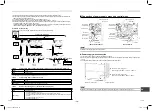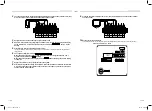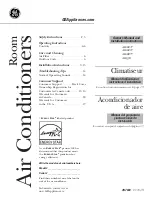
– 9 –
17-EN
18-EN
Extruding margin of copper pipe with
fl
are machining: B (Unit: in (mm))
Copper pipe outer
dia.
When using R410A
tool
When using
conventional tool
3/8" (9.5)
1/2"(12.7)
5/8" (15.9)
3/4" (19.1)
0 - 0.02"
(0 - 0.5)
0.04" - 0.06"
(1.0 - 1.5)
Extruding margin of copper pipe with
fl
are tools: A (Unit: in (mm))
Copper pipe outer
dia.
A
+0
–0.02" (–0.4)
3/8" (9.5)
0.52" (13.2)
1/2"(12.7)
0.65" (16.6)
5/8" (15.9)
0.78" (19.7)
3/4" (19.1)
0.94" (24.0)
* When using the conventional flare tool, to connect R410A pipes with flaring, make a margin approx.
0.02" (0.5 mm) longer than that of an R22 pipe so that the flare size matches the one specified. It is convenient
to use a copper pipe gauge for size adjustment of the extruding margin.
CAUTION
Wrap the ball valve in a wet cloth to keep it cool and prevent the heat from the
torch from damaging it when connecting the pipe to the ball valve on the gas line.
Cloth
Torch
Coupling size of brazed pipe
Connected section
External size
Internal size
K
ØC
G
ØF
Standard
outer dia.
of connected
copper pipe
Connected section
Min.
thickness
of
coupling
External size
Internal size
Min. depth of
insertion
Oval value
Standard outer dia.
(Allowable difference)
C
F
K
G
in
mm
in
mm
in
mm
in mm in mm
in
mm
in
mm
Ø1/4
6.35
1/4"(±0.0012)
6.35(±0.03) 0.25" (
+0.0016
−
0.0008
) 6.45 (
+0.04
−
0.02
) 0.28 7 0.24 6 0.0024" or less 0.06 or less 0.020" 0.50
Ø3/8
9.52
3/8"(±0.0012)
9.52(±0.03) 0.38" (
+0.0016
−
0.0008
) 9.62 (
+0.04
−
0.02
) 0.31 8 0.28 7 0.0031" or less 0.08 or less 0.024" 0.60
Ø1/2
12.7
1/2"(±0.0012) 12.70(±0.03) 0.5" (
+0.0016
−
0.0008
) 12.81 (
+0.04
−
0.02
) 0.35 9 0.31 8 0.0039" or less 0.10 or less 0.028" 0.70
Ø5/8 15.88 5/8"(±0.0012) 15.88(±0.03) 0.63" (
+0.0016
−
0.0008
) 16.00 (
+0.04
−
0.02
) 0.35 9 0.31 8 0.0051" or less 0.13 or less 0.031" 0.80
Ø3/4 19.05 3/4"(±0.0012) 19.05(±0.03) 0.76" (
+0.0012
−
0.0012
) 19.19 (
+0.03
−
0.03
) 0.43 11 0.39 10 0.0059" or less 0.15 or less 0.031" 0.80
Ø7/8
22.2
7/8"(±0.0012) 22.22(±0.03) 0.88" (
+0.0012
−
0.0012
) 23.36 (
+0.03
−
0.03
) 0.43 11 0.39 10 0.0063" or less 0.16 or less 0.032" 0.82
Ø1-1/8 28.58 1-1/8"(±0.0012) 28.58(±0.04) 1.13" (
+0.0024
−
0.0008
) 28.75 (
+0.06
−
0.02
) 0.51 13 0.47 12 0.0079" or less 0.20 or less 0.039" 1.00
Ø1-3/8 34.92 1-3/8"(±0.0012) 34.90(±0.04) 1.38" (
+0.0016
−
0.0016
) 35.11 (
+0.04
−
0.04
) 0.55 14 0.51 13 0.0098" or less 0.25 or less 0.047" 1.20
Ø1-5/8 41.28 1-5/8"(±0.0012) 41.28(±0.05) 1.63" (
+0.0031
−
0.0008
) 42.28 (
+0.08
−
0.02
) 0.59 15 0.55 14 0.0110" or less 0.28 or less 0.053" 1.35
■
Selection of pipe size
◆
Capacity code of indoor and outdoor units
Selection of pipe material
• For the indoor unit, the capacity code is decided at each capacity type. (Table 1)
• The capacity codes of the outdoor units are decided at each capacity type. The maximum number of connectable
indoor units and the total value of capacity codes of the indoor units are also decided. (Table 2)
NOTE
Compared with the capacity code of the outdoor unit, the total value of capacity codes of the connectable indoor
units differs based on the height difference between the indoor units.
When the height difference between the indoor units is 49 ft (15 m) or less
Total indoor capacity code must be between 80% and 135% of the capacity of the outdoor unit.
When the height difference between the indoor units is over 49 ft (15 m)
Total indoor capacity code must be between 80% and 105% of the capacity of the outdoor unit.
• If MMU-AP0072H2UL-1 or MMU-AP0122H2UL is included in the system, total indoor capacity code must be
between 80% and 100% of outdoor unit capacity.
• If MMD-AP
∗∗∗
BH is included in the system, total indoor capacity code must be,
• when the height difference between the indoor units is over 49 ft (15 m): between 80% and 105%
• when the height difference between the indoor units is 49 ft (15 m) or less: between 80% and 120%
* If the system con
fi
gure only the limited indoor unit type and limited number of connection indoor unit, total indoor
capacity code up to 150% of the outdoor capacity code is available when the height difference between the
indoor units is 49 ft (15 m) or less.
• If the minimum capacity of the connected indoor units is to be more than 50% and less than 80%, there are
limiting conditions.
For more information, please refer to the engineering data book.
1122001101_EN FR.indd 9
1122001101_EN FR.indd 9
7/8/16 2:37 PM
7/8/16 2:37 PM
50
50
For more information, please refer to the engineering data book.
* Permanent operation below 80 % is not recommended.











































